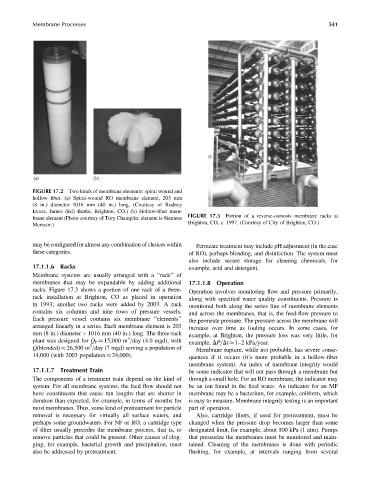Page 586 - Fundamentals of Water Treatment Unit Processes : Physical, Chemical, and Biological
P. 586
Membrane Processes 541
(a) (b)
FIGURE 17.2 Two kinds of membrane elements: spiral wound and
hollow fiber. (a) Spiral-wound RO membrane element, 203 mm
(8 in.) diameter 1016 mm (40 in.) long. (Courtesy of Rodney
Evans, James (Ed) Burke, Brighton, CO.) (b) Hollow-fiber mem-
FIGURE 17.3 Portion of a reverse-osmosis membrane racks at
brane element (Photo courtesy of Tory Champlin; element is Siemens
Brighton, CO, c. 1997. (Courtesy of City of Brighton, CO.)
Memcor.)
may be configured for almost any combination of choices within Permeate treatment may include pH adjustment (in the case
these categories. of RO), perhaps blending, and disinfection. The system must
also include secure storage for cleaning chemicals, for
17.1.1.6 Racks example, acid and detergent.
Membrane systems are usually arranged with a ‘‘rack’’ of
membranes that may be expandable by adding additional 17.1.1.8 Operation
racks. Figure 17.3 shows a portion of one rack of a three- Operation involves monitoring flow and pressure primarily,
rack installation at Brighton, CO as placed in operation along with specified water quality constituents. Pressure is
in 1993; another two racks were added by 2003. A rack monitored both along the series line of membrane elements
contains six columns and nine rows of pressure vessels. and across the membranes, that is, the feed-flow pressure to
Each pressure vessel contains six membrane ‘‘elements’’ the permeate pressure. The pressure across the membrane will
arranged linearly in a series. Each membrane element is 203 increase over time as fouling occurs. In some cases, for
mm (8 in.) diameter 1016 mm (40 in.) long. The three-rack example, at Brighton, the pressure loss was very little, for
3
plant was designed for Q P 15,000 m =day (4.0 mgd), with example, DP=Dt 1–2 kPa=year.
3
Q(blended) 26,500 m =day (7 mgd) serving a population of Membrane rupture, while not probable, has severe conse-
14,000 (with 2003 population 24,000). quences if it occurs (it’s more probable in a hollow-fiber
membrane system). An index of membrane integrity would
17.1.1.7 Treatment Train be some indicator that will not pass through a membrane but
The components of a treatment train depend on the kind of through a small hole. For an RO membrane, the indicator may
system. For all membrane systems, the feed flow should not be an ion found in the feed water. An indicator for an MF
have constituents that cause run lengths that are shorter in membrane may be a bacterium, for example, coliform, which
duration than expected, for example, in terms of months for is easy to measure. Membrane integrity testing is an important
most membranes. Thus, some kind of pretreatment for particle part of operation.
removal is necessary for virtually all surface waters, and Also, cartridge filters, if used for pretreatment, must be
perhaps some groundwaters. For NF or RO, a cartridge type changed when the pressure drop becomes larger than some
of filter usually precedes the membrane process, that is, to designated limit, for example, about 100 kPa (1 atm). Pumps
remove particles that could be present. Other causes of clog- that pressurize the membranes must be monitored and main-
ging, for example, bacterial growth and precipitation, must tained. Cleaning of the membranes is done with periodic
also be addressed by pretreatment. flushing, for example, at intervals ranging from several

